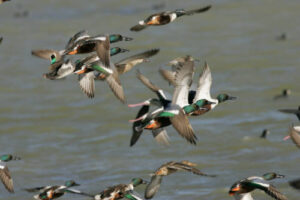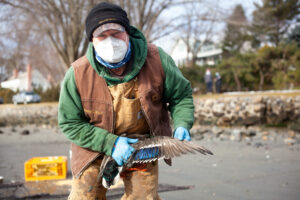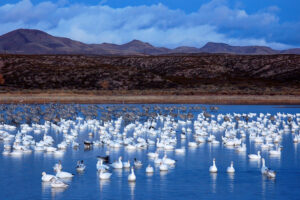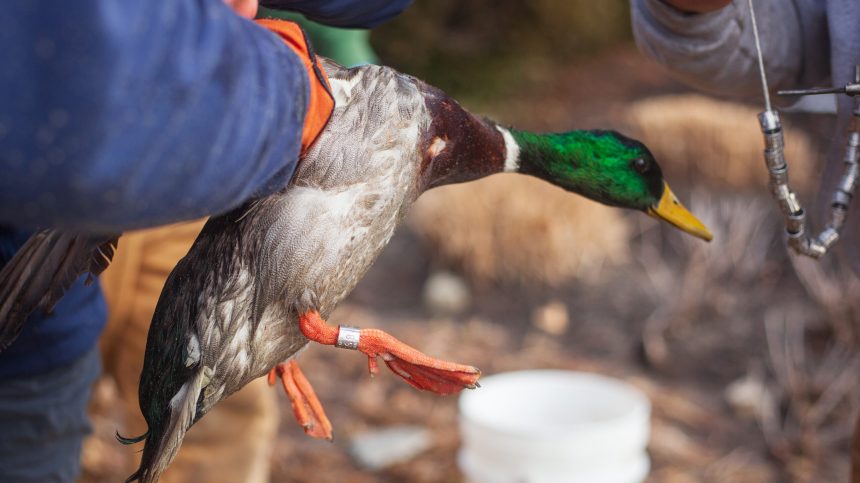By Sam Moore
In a management effort marked by collaboration, Federal Wildlife Restoration grants connect states, federal agencies and the public with waterfowl.
On a sunny morning last January, I joined a group of MassWildlife biologists on a mallard banding mission on the Atlantic coast. Equipped with a tub net launcher, a bucket of corn, and a dose of good luck, we captured a few dozen ducks, recorded their age, and set each free with a new metal leg band.
My morning in the field was a glimpse into one of the largest and longest running cooperative conservation efforts in history — waterfowl management in North America. These ducks represented just a fraction of more than 30,000 mallards banded in Massachusetts since 1960, and of more than 4.3 million banded across the country over the same period, according to the USGS Bird Banding Laboratory.
Overall, more than 20 million ducks, geese and swans have been banded in North America since comprehensive records began in 1960. It’s a cornerstone technique of “arguably the best monitoring system in the world for continentally distributed animal populations.” (Nichols, Johnson and Williams, 1995).
Hunters, birdwatchers and biologists are familiar with banding and other aspects of waterfowl management. Those engaged in the field with fowl and feathers may also be familiar with some key conservation programs, like federal and state duck stamps, the Migratory Bird Treaty Act, the North American Wetlands Conservation Act, and the North American Waterfowl Management plan.
Less familiar, even within the conservation world, is another program that rivals these in scope and complements nearly every aspect of waterfowl management in America: the Wildlife Restoration Act, known as Pittman-Robertson, which each year apportions more than half a billion dollars to state fish and wildlife agencies for wild bird and mammal conservation.
Derived from excise taxes on firearms, ammunition and archery equipment, since 1937 this program has delivered almost 13 billion dollars to state agencies for wildlife restoration, and it’s a long-term catalyst for the local, regional, and international partnerships that make conservation happen.
State agencies use Wildlife Restoration funding to help them conduct most of their work except for law enforcement, which means that it supports waterfowl, too — banding, surveys, habitat acquisition, restoration and management, research, the training of new biologists, and programs that serve the public by connecting people to wild birds.
The story of ducks, geese and swans is a story that involves a lot of people. More than 45 million birders and more than 2.3 million migratory bird hunters engage with wild birds each year in America, according to the last National Survey of Fishing, Hunting, and Wildlife-Associated Recreation. Recent estimates from the Fish and Wildlife Service show that hunters harvest 10-12 million ducks in a typical year, as well as 2-4 million geese.
For the millions of hunters who eat and share wild birds for protein, waterfowl conservation is table stakes. The Wild Harvest Initiative, which collects harvest data in the United States and Canada, estimates that wild ducks produced almost 60 million meals from the 2014 through 2016 seasons alone. Of this, almost 25 million meals came from mallards.
Wildlife Restoration Funds Help Waterfowl Soar
Like the confluence of natural resources and bird life found in a river delta, good waterfowl management happens when “all the braided streams start flowing,” said Chris Dwyer, a longtime bird biologist in the Wildlife and Sport Fish Restoration program of the U.S. Fish and Wildlife Service.
To Dwyer’s point, a remarkable feature of bird banding, and so many other projects involving waterfowl, is the distributed and cooperative nature of the people involved — what former Interior Secretary Stewart Udall called “the ceaseless work for the perpetuation and wise use of North America’s magnificent migratory bird resources.”

Hundreds of state and federal biologists work together to study populations, set harvest regulations, and plan for the future. Flyway councils, joint ventures, and other cooperative governance structures lay the groundwork for a continental-scale effort — and many of the mechanisms in play are fueled by Wildlife Restoration funding.
“It runs the gamut,” Dwyer said. “You’ve got a large amount of Wildlife and Sport Fish Restoration funding that’s going into the acquisition and management of wildlife management areas for a variety of habitat types and species. Every state has a different emphasis on what portion of the annual cycle they’re trying to support waterfowl conservation around.”
States also do extensive research and monitoring each year. “All that…from the state side is funded by WSFR,” said Dwyer. “All the harvest management information needs. There’s some effort that’s done in the states in August and September before the duck seasons open, it’s called preseason waterfowl banding.”
Regarding the North American Waterfowl Management Plan, an international conservation strategy created in 1986, “everyone’s bringing a chunk to the table,” Dwyer said. “States are certainly doing a big part of it. You’ve got some wildlife management areas in the prairie pothole region that focus on breeding waterfowl, some in the Gulf coast region and along the Atlantic coast and Great Lakes focusing on wintering waterfowl.” A lot of coordination and hard work have gone into “not only delivering the habitat but managing it and also supporting the science that is needed to inform harvest management decision-making at the flyway scale,” he said.
In a conservation world where trajectories are often grim, Dwyer points to waterfowl as an inspiring example of real success. In 2019’s startling “Decline of the North American avifauna” paper (Rosenberg, et al. 2019), waterfowl were the only management group to show a net increase since 1970, and wetlands were the only breeding biome with a net increase in avifauna.
“Everyone recognizes the value that wetlands provide, the diverse community of wildlife,” Dwyer said. “We spend a tremendous amount of time, effort and money and professional knowledge managing some of these habitats, traditionally with the thought of focusing on waterfowl, but also recognizing that it’s provided a tremendous amount of habitat for other species that benefit as well.”
“That’s really the lesson that people have been recognizing the past couple years,” Dwyer said. “Waterfowl conservation and management, while it certainly is of interest for harvest management and conservation of waterfowl, it’s also helped reduce the losses of all these other wetland wildlife species and migratory birds.”
As an example, he pointed to Red Knots, which often utilize waterfowl impoundments along with other migratory shorebirds — impoundments that are often maintained with Wildlife Restoration funds. “It’s not only the acquisition, but the operation and maintenance” of Wildlife Management Areas, he said, “particularly for impoundments where you end up having to spend a tremendous amount of time manipulating water levels to get the right vegetation response.”
State waterfowl work often supports joint ventures, the cooperative partnerships that emerged from the North American Waterfowl Management Plan. “New York and New Jersey have a really unique project underway,” said Dwyer. Using a Wildlife Restoration grant, New York’s Department of Environmental Conservation and New Jersey’s Division of Fish and Wildlife are using GPS-GSM units to track Atlantic Brant, which are covered by the Arctic Goose Joint Venture.
These geese winter in both states, said Dwyer, “and they’re tracking them to their breeding grounds and back to see what pathways they’re taking and the timing of departure and stop over locations, all sorts of things.” Atlantic brant in the U.S. are very much affected by breeding conditions in the eastern high arctic, Dwyer said, “so having an idea of where they are, how they might be shifting in the Arctic, and what habitats they are shifting to, it’s really interesting stuff.”
Research like this is a useful product of the federal-state partnership — thousands of students have benefitted from Wildlife Restoration funding in almost a century of collaborative research, and not just in biology. A new generation of human dimensions researchers are illuminating the connections between wildlife and society, and many of them are working on projects aligned with the people-focused goals in the recently updated Waterfowl Management Plan.
“A tremendous amount of science has been gained through the direct funding from Wildlife and Sport Fish Restoration dollars to universities to inform decisions for state agencies,” Dwyer said. This resource pays off twofold — it helps states meet their research needs to inform decision making, and it cultivates a new cohort of wildlife professionals.
This kind of informed management has helped waterfowl populations through multiple crises since the Wildlife and Sport Fish Restoration program’s beginning in 1937 — the drought conditions of the 1930s and 1940s, and the historic lows that led to the 1986 Waterfowl Management Plan, for example. At every step of the way, state agencies and biologists have studied species, protected habitat, engaged with the public, and planned for the future supported by these funds.

Waterfowl and Pittman-Robertson are joined at the HIP
John Organ, former director of the Wildlife and Sport Fish Restoration program in the Northeast, and then Chief of the USGS Cooperative Fish and Wildlife Research Units, has a keen grasp on the multitude of state and federal agencies, nonprofits, research institutions, and public stakeholders that have a hand in the waterfowl management process — not to mention the many interlocking layers of law and policy, from sweeping international treaties to local regulations that govern fowl and feathers nationwide.
“From that bird’s eye perspective, the Pittman-Robertson act and waterfowl conservation were intertwined from the get-go,” Organ told me. “Because the funding mechanism was virtually tied to migratory birds, the rationale for wildlife restoration was strongly justified based on what to do about waterfowl at the time. They were joined at the hip.”
They’re joined at the HIP survey, too — that’s the Harvest Information Program for migratory birds, a cooperative effort between the Fish and Wildlife Service, state agencies, and the hunting public that began in the 1990s. The survey is a good symbol for the collaboration around waterfowl in general: each year a subset of migratory bird hunters respond to a voluntary survey, and state and federal biologists use this information to form a reliable estimate of each year’s harvest by species and region.
This kind of cooperation is not only fruitful, but necessary. Waterfowl transcend political boundaries in their migration, so it’s left up to the people that care about these birds — wildlife biologists, hunters, birdwatchers, and conservation groups among them — to organize along their route.
Oliver Wendell Holmes, the justice who wrote the Supreme Court’s opinion upholding the Migratory Bird Treaty act in 1920, observed that states have “the presence within their jurisdiction of birds that yesterday had not arrived, tomorrow may be in another state and in a week a thousand miles away.”
This transience, said Organ, was key to forming a broad conservation coalition for the Wildlife Restoration Act. “Different states may have had different issues,” he said. “It may have been pronghorn in Wyoming, it may have been elk in Nevada, white tailed deer and turkey in some of the Northeastern states, but waterfowl was something that was really common to all of the jurisdictions.”
“The duck stamp came into play to purchase federal lands,” Organ said. “But the push for Pittman-Robertson was that there needed to be a state-based program.” Aware that states already had some resources from license sales, legislators saw the need for a federal funding source to match. “A lot of the rationale for that need was waterfowl,” said Organ.
Indeed, the very first federal grant for Wildlife Restoration was aimed at waterfowl — at the Ogden Bay Waterfowl Management Area in Utah’s Weber River Delta, on the Eastern shore of the Great Salt Lake. To mitigate severe outbreaks of botulism, the state used the funding to build habitat and control water levels. In the many decades since, Wildlife Restoration funding has continued to support the property.
Other states quickly followed suit. Iconic duck habitats like Sauvie Island in Oregon, Willough Slough in Indiana, Fountain Grove in Missouri, the enormous Roseau River marsh in Minnesota, and many others were acquired early in the Wildlife Restoration program’s history, and states have conserved many more wetlands since.
By 1970, only a few decades into the program, states had used Wildlife Restoration funding to acquire waterfowl habitat covering a cumulative area of more than a million acres — including breeding, stopover, and wintering grounds.
Directly acquired habitat is just a fraction of the conservation value leveraged with this Wildlife Restoration money. La Joya Waterfowl Management Area in New Mexico is a useful example. Acquired in the 1920s as a small state-owned parcel along the Rio Grande, after the passage of the Pittman-Robertson act federal funds helped expand the property and several others nearby to form today’s Ladd S. Gordon Waterfowl Complex. Together with the Bosque del Apache National Wildlife Refuge, this strategic conservation area forms a whole greater than the sum of its parts as a world-renowned destination for wintering waterbirds.

Organ pointed out that not just land, but key parts of waterfowl governance are funded by Pittman-Robertson. The North American Waterfowl Management Plan, for one. “That was established in the late nineteen eighties,” he said, “and I was very much involved at that time. Not in the writing of the plan, but in the implementation, because the funding for that came from reverted Pittman-Robertson funds.”
Wildlife Restoration funding remains a pillar of the Waterfowl Management Plan through the North American Wetlands Conservation Act — in fiscal year 2020, interest from the Wildlife Restoration account exceeded congressional appropriations for the wetland program. Multistate conservation grants, which are also derived from Wildlife Restoration funding, help support the Migratory Bird Joint Ventures.
These and other crucial waterfowl initiatives arose from the 20th century’s boom in professional wildlife management and research, much of it driven by staffing and resource increases at state agencies that drew on Wildlife and Sport Fish Restoration funding to meet their goals.
Organ rattled off several more major waterfowl projects involving Wildlife Restoration funds, like the Eastern Canada waterfowl banding project that was first established in 1955, and the many mid-winter and spring surveys conducted by states to compliment the continental-scale North American Waterfowl Survey. He remembers flying “from the Hudson River in New York to the St. Croix river in Maine. We would fly transects two hundred feet over the ground all the way down the coast in December or January counting black ducks,” he said.
As both Chris Dwyer and John Organ told me, the major technologies and infrastructures in the waterfowl world arose through effective cooperation. Count and capture methods like aerial and ground surveys, net guns, and swim-in traps, tracking techniques like banding, radio telemetry and GPS collars, and exciting new tools like genomics have all been developed and perfected by biologists working together across borders and disciplines — and many of them have relied on Wildlife Restoration funding at some stage of their career.
Waterfowl management would not have been such a priority in the 20th century and beyond without public buy-in, and the Wildlife and Sport Fish Restoration program, like state fish and wildlife agencies, has a mandate to connect people with nature and wildlife. Wildlife Restoration grants ensure public access to land for hunting, fishing, trapping and other activities, and welcome new people to the outdoors through hunter and aquatic education.
These programs broaden the network of people who care about wildlife, who know about the work being done to conserve it, and who advocate for that work to continue. More than a million people attend hunter education programs every year because of Wildlife Restoration funding, programs that help them get to know the people in their state wildlife agencies and find affinity with other hunters.
Much of the value of Wildlife Restoration funding for state agencies, according to John Organ, is its persistence as a resource. “There’s a lot of ongoing survey and monitoring work as well as land management and land acquisition,” he said. “It keeps the engine going. The beauty of it is that it reduces the uncertainty. You know that you’re going to have a project with funding out to the future, so you can plan for the long term.”
The partnerships that make the Wildlife and Sportfish Restoration program possible are ones between state fish and wildlife agencies, the U.S. Fish and Wildlife Service, and the manufacturers who support conservation through excise taxes on the firearms, ammunition and archery products they produce.

